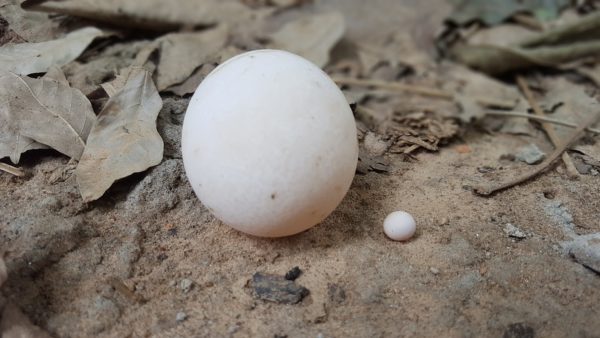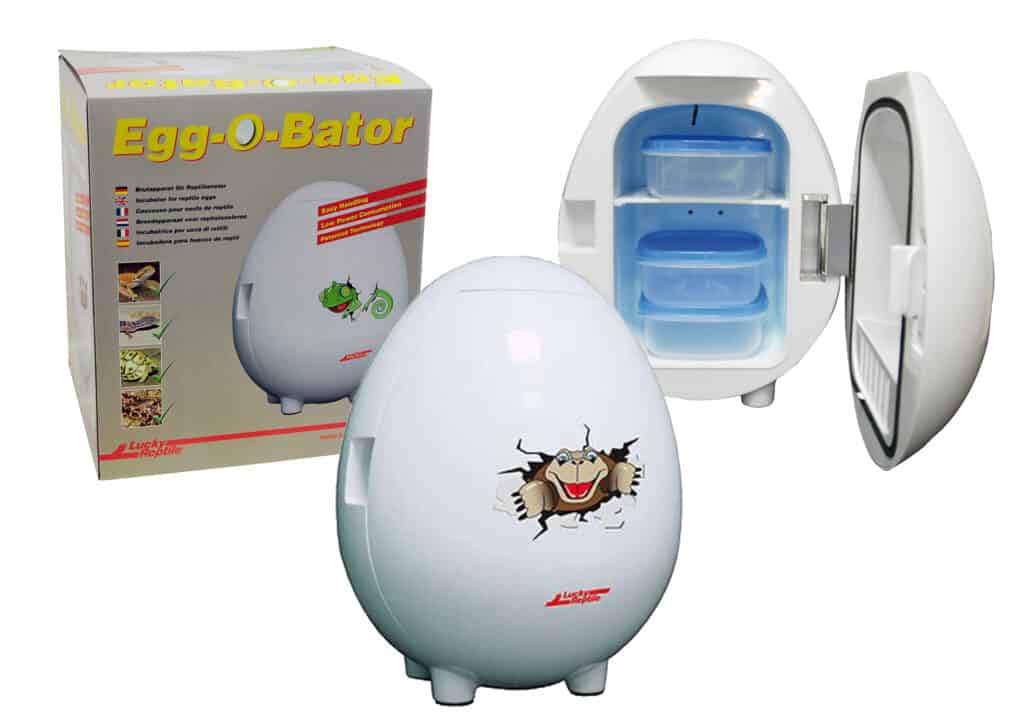
To the uninitiated it might seem silly that someone who owns multiple tortoises could be surprised when they find one of them has not only laid some eggs, but that those eggs go on to hatch.
Should this happen, there’s no need to panic. If the eggs are fertilised there are a few simple steps you can take to ensuring the baby tortoises are able to survive and hatch; most important of all is careful handling of the eggs and incubating them at the right temperature range [27°C – 32°C (80°F – 90°F)
The bottom line here is not to panic if your tortoise does lay eggs. As long as you’re astute enough to do everything you can to make sure you’re caring for your tortoise correctly, you’ll be well on the way to making sure you can manage things should they ever lay eggs.

>>> Click for pricing and reviews on Amazon <<<
An Unexpected Litter
Knowing how notoriously difficult it can be to determine the sex of a tortoise, especially during the earliest years of development, it isn’t beyond the realms of possibility to find you’ve really got Teresa not Terrance living in the back yard.
As if confusion over gender wasn’t enough of a curve-ball, there’s another rather unusual element to tortoise biology that can leave you scratching your head, a trait that has evolved to maximize the chance of conception.
Essentially females have the ability to store sperm in their bodies for months and even years at a time! Under these conditions this sperm is able to stay viable, and in theory can impregnate the female years after the act of mating that implanted the sperm in the first place.
What this means of course is that you could take ownership of a mature tortoise, not take any particular notice of what sex they are, only to find them pregnant and/or giving birth after a few years in your ownership. This would be surprising to say the least!
It’s worth noting that this ‘dormant’ sperm fertilization phenomena is most likely to be overruled should another male mate with the female in the meantime.
How do I know if my Tortoise is About to Lay Eggs?
I’m not usually one to draw comparisons between tortoises and people, but anyone who has ever been in labor/or witnessed someone who is, will know that there are some similarities!
Just as women in labor find themselves getting restless, unable to get comfortable, and generally distressed, so to do tortoises, albeit for slightly different reasons.
If your tortoise is restlessly stalking around their enclosure, not eating, and not settling down to bask as they normally would, it could be a sign that something is brewing! Besides any discomfort and agitation that might be distracting them, the main reason your tortoise will behave this way is because they’re busy looking for a nesting site.
Along with their strange behavior you can get a rough idea of whether a tortoise is in egg laying mode by the time of year. The egg laying ‘season’ tends to be in the summer between July and August.
When the tortoise finds a suitable nesting site she will spend a good couple of hours digging a nesting hole before proceeding to her eggs.
Where do Tortoises Prefer to Lay Eggs?
For a nesting hole to retain its shape the soil must be suitably claggy, therefore very sandy soils aren’t preferred. Slightly sloped areas are preferred because any moisture is able to drain away, and likewise areas in direct sunlight ensure the eggs are (in theory at least) suitably incubated.
If you’ve got suspicions that your tortoise might be preparing to lay her litter (even if you’d assumed she was actually a he) and you don’t have such conditions within her reach, it’s advisable to do what you can to provide them.
If a female determines that she doesn’t have access to a suitable nesting site, she will instinctively hold her eggs in. If this goes on for too long it can prove fatal to the tortoise, so it’s important to recognize the signs if you possibly can.
Can Tortoises Lay Unfertilised Eggs Like Chickens do?
Is is certainly possible for a tortoise to lay unfertilized eggs. Once they reach maturity you might find they lay eggs, perhaps on just one single occasion, every year, or somewhere in between. It really depends on the individual tortoise.
I’m not sure whether it’s a pheromone or some other mechanism, but when a female is in the presence of a male, yet without actually mating with him, she is more likely to produce eggs than if kept exclusively with other females, or indeed on her own. So if you want to avoid the distress and risks involved in producing eggs, whether fertilized or not, you would do well to keep your female tortoise well clear of any males, even if they can’t physically make contact.
Some people argue that if a female has a tendency to lay eggs more frequently then it could be a positive sign that she is being well cared for. When you think about it, creating eggs takes a lot of energy and nutrition that the mother tortoise could otherwise benefit from herself. So if her body creates eggs it may mean that she is exposed to ideal conditions and an abundance of food. This is just a theory however!
How Can I Tell if the Eggs Are Fertilised?
If your tortoise does lay eggs you’ll want to be able to determine whether or not they contain fledgling tortoises as soon as possible, so that you can provide the right conditions for them to grow and develop, and with any luck, hatch.
The first indicator of fertilized eggs is what’s known as ‘chalking’, which is basically a tell tale ‘whitening’ of the shell, usually starting with a white circle or band running around the egg, which up until this point will have been a transparent pinky colour. Eventually this whitening will spread across the entire egg.
The other trick to see what’s going on inside an egg is a technique known as ‘candling’, which as the name suggests involves shining a bright light through the egg. These days the advent of high intensity LED flashlights makes this easy to do, by turning the lights off in the room and shining the flashlight on the eggs.
The thing to look for when candling is a network of blood vessels, indicating the presence of the developing tortoise.
Oh and don’t worry, candling isn’t harmful to the developing hatchlings.
It is important to remember that you should only move eggs immediately after they have been laid (usually within two days); as soon as chalking becomes evident it’s a sign that the developing tortoise has latched onto one side of the egg shell where it will continue to develop. Moving the egg at this point could cause the tortoise to detach, at which point it will no longer be able to continue to develop and therefore won’t survive.
How Long Does it Take a Tortoise Egg to Hatch Once Laid?
As you might expect this depends largely on the temperature at which the eggs are incubated. Just as more mature tortoises are able to metabolize their food more effectively, and move more quickly when the ambient temperature around them is optimal; developing hatchlings are also able to grow more quickly if they are incubated within the correct temperature range.
Most tortoise eggs are best incubated at between 30°C-31°C (86°F-88.7°F) and if incubated at this temperature you can expect the eggs to hatch at around 8 to 11 weeks after laying. In general the lower the temperature the longer the incubation period.
Interestingly, the duration of incubation can go some way toward determining the sex of the tortoise, with lower temperatures (and thus a longer incubation period) producing females, while higher temperatures (and thus a shorter incubation period) tend to produce males.
Either way, the important thing to remember is that a safe overall temperature range for incubation is between 27°C – 32°C (80°F – 90°F). The temperature should never exceed 34°C (93°F) as this can lead to severe health issues, and more likely death among the developing hatchlings.
How do I Look After Eggs at Home?
The most important thing to remember about incubation is that you must be able to maintain a consistent temperature for the duration of the process. If you’re planning on breeding tortoises semi professionally then your best bet is to opt for a commercially available incubator, the kind of thing typically designed for chicks.
If you’re dealing with an unexpected litter however you’ll probably plump for more of a DIY method, which can be just as effective, as long as you’re disciplined about monitoring the temperature.
Some ideas for incubation include:
- Carefully placing the eggs in an egg (as in chicken egg!) carton with the top removed, and placing it in a spare vivarium (if you have one). Placing the eggs directly under, and closer to the heat lamp than usual should expose them to the higher temperature they require, but of course you’ll need to check the ambient air temperature between the lamp and the eggs when you do so
- Carefully burying the eggs in a bucket of sand so that they are just visible below the surface. This can then be positioned outside of an enclosure (but away from any potential danger) with a desk lamp (fitted with a heat bulb) angled downwards and facing the eggs
- Using a ‘hobby’ level commercially available incubator such as the ever popular ‘Egg-O-Bator’ by Lucky Reptile.
Is there an Age When a Female Will Stop Laying?
If you were relying on the safety net of thinking your tortoise was too old to burden you with eggs to incubate, then you might want to think again!
Most sources seem to agree that tortoise’s, and possibly other reptiles differ from mammals entirely in this regard in that they don’t experience the menopause. Unfortunately this means you’ll never be able to let your guard down entirely if you have an older female bunking in with a male!

